1.2 44The Foreign Exchange Market
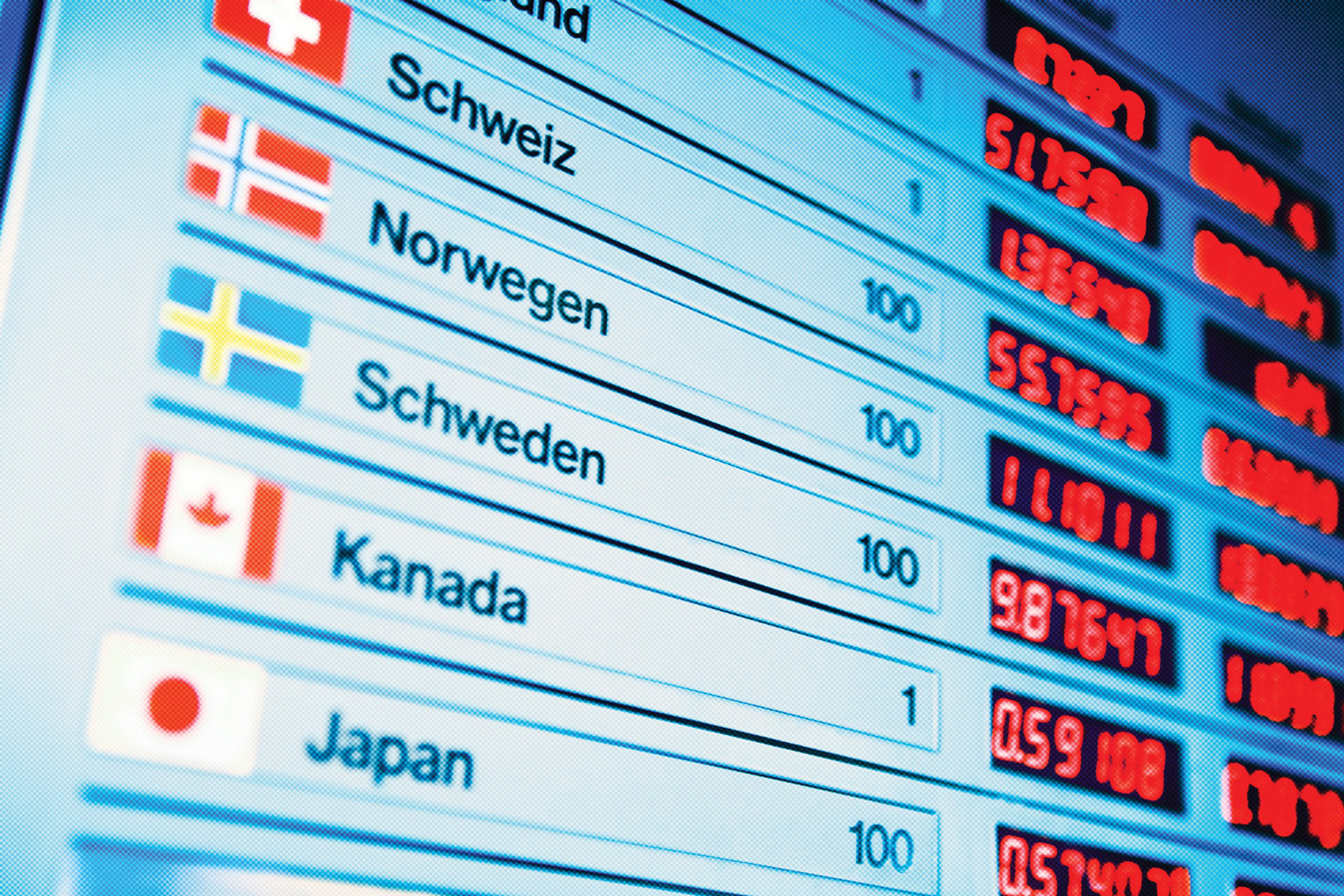
WHAT YOU WILL LEARN
 The role of the foreign exchange market and the exchange rate
The role of the foreign exchange market and the exchange rate
 The importance of real exchange rates and their role in the current account
The importance of real exchange rates and their role in the current account
The Role of the Exchange Rate
We’ve just seen how differences in the supply of loanable funds from savings and the demand for loanable funds for investment spending lead to international capital flows. We’ve also learned that a country’s balance of payments on the current account plus its balance of payments on the financial account add up to zero: a country that receives net capital inflows must run a matching current account deficit, and a country that generates net capital outflows must run a matching current account surplus.
The behavior of the financial account—
So given that the financial account reflects the movement of capital and the current account reflects the movement of goods and services, what ensures that the balance of payments really does balance? That is, what ensures that the two accounts actually offset each other?
The answer lies in the role of the exchange rate, which is determined in the foreign exchange market.
Understanding Exchange Rates
In general, goods, services, and assets produced in a country must be paid for in that country’s currency. American products must be paid for in dollars; European products must be paid for in euros; Japanese products must be paid for in yen. Occasionally, sellers will accept payment in foreign currency, but they will then exchange that currency for domestic money.
Currencies are traded in the foreign exchange market.
The prices at which currencies trade are known as exchange rates.
International transactions, then, require a market—
Table 44-1 shows exchange rates among the world’s three most important currencies as of 7:50 a.m., EST, on May 13, 2013. Each entry shows the price of the “row” currency in terms of the “column” currency. For example, at that time US$1 exchanged for €0.7701, so it took €0.7701 to buy US$1. Similarly, it took US$1.2985 to buy €1. These two numbers reflect the same rate of exchange between the euro and the U.S. dollar: 1/1.2985 = €0.7701.
44-1
Exchange Rates, May 13, 2013 7:50 a.m.
![TABLE 44-1: Exchange Rates, May 13, 2013 7:50 [phrase block_type='smallcap']a.m[/phrase].](asset/Sec13/ch44_tab01.jpg)
There are two ways to write any given exchange rate. In this case, there were €0.7701 to US$1 and US$1.2985 to €1. Which is the correct way to write it? The answer is that there is no fixed rule. In most countries, people tend to express the exchange rate as the price of a dollar in domestic currency. However, this rule isn’t universal, and the U.S. dollar–
When a currency becomes more valuable in terms of other currencies, it appreciates.
When a currency becomes less valuable in terms of other currencies, it depreciates.
When discussing movements in exchange rates, economists use specialized terms to avoid confusion. When a currency becomes more valuable in terms of other currencies, economists say that the currency appreciates. When a currency becomes less valuable in terms of other currencies, it depreciates. Suppose, for example, that the value of €1 went from $1 to $1.25, which means that the value of US$1 went from €1 to €0.80 (because 1/1.25 = 0.80). In this case, we would say that the euro appreciated and the U.S. dollar depreciated.
Movements in exchange rates, other things equal, affect the relative prices of goods, services, and assets in different countries. Suppose, for example, that the price of an American hotel room is US$100 and the price of a French hotel room is €100. If the exchange rate is €1 = US$1, these hotel rooms have the same price. If the exchange rate is €1.25 = US$1, the French hotel room is 20% cheaper than the American hotel room. If the exchange rate is €0.80 = US$1, the French hotel room is 25% more expensive than the American hotel room.
But what determines exchange rates? Supply and demand in the foreign exchange market.
The Equilibrium Exchange Rate
Imagine, for the sake of simplicity, that there are only two currencies in the world: U.S. dollars and euros. Europeans wanting to purchase American goods, services, and assets come to the foreign exchange market to exchange euros for U.S. dollars. That is, Europeans demand U.S. dollars from the foreign exchange market and, correspondingly, supply euros to that market.

Americans wanting to buy European goods, services, and assets come to the foreign exchange market to exchange U.S. dollars for euros. That is, Americans supply U.S. dollars to the foreign exchange market and, correspondingly, demand euros from that market. (International transfers and payments of factor income also enter into the foreign exchange market, but to make things simple, we’ll ignore these.)
Figure 44-1 shows how the foreign exchange market works. The quantity of dollars demanded and supplied at any given euro–
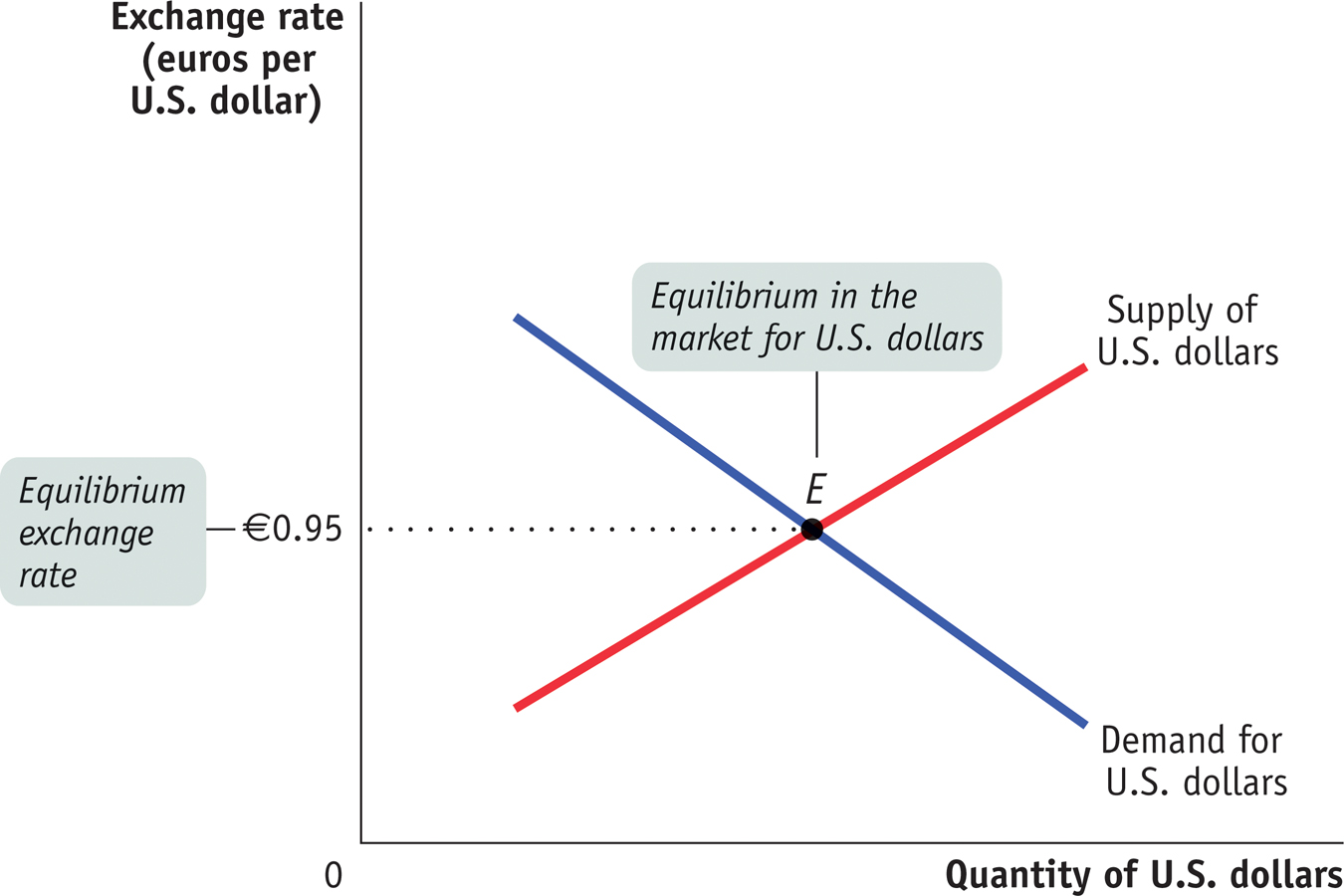
The figure shows two curves, the demand curve for U.S. dollars and the supply curve for U.S. dollars. The key to understanding the slopes of these curves is that the level of the exchange rate affects exports and imports. When a country’s currency appreciates (becomes more valuable), exports fall and imports rise. When a country’s currency depreciates (becomes less valuable), exports rise and imports fall.
To understand why the demand curve for U.S. dollars slopes downward, recall that the exchange rate, other things equal, determines the prices of American goods, services, and assets relative to those of European goods, services, and assets. If the U.S. dollar rises against the euro (the dollar appreciates), American products will become more expensive to Europeans relative to European products. So Europeans will buy less from the United States and will acquire fewer dollars in the foreign exchange market: the quantity of U.S. dollars demanded falls as the number of euros needed to buy a U.S. dollar rises.
If the U.S. dollar falls against the euro (the dollar depreciates), American products will become relatively cheaper for Europeans. Europeans will respond by buying more from the United States and acquiring more dollars in the foreign exchange market: the quantity of U.S. dollars demanded rises as the number of euros needed to buy a U.S. dollar falls.
A similar argument explains why the supply curve of U.S. dollars in Figure 44-1 slopes upward: the more euros required to buy a U.S. dollar, the more dollars Americans will supply. Again, the reason is the effect of the exchange rate on relative prices. If the U.S. dollar rises against the euro, European products look cheaper to Americans—
The equilibrium exchange rate is the exchange rate at which the quantity of a currency demanded in the foreign exchange market is equal to the quantity supplied.
The equilibrium exchange rate is the exchange rate at which the quantity of U.S. dollars demanded in the foreign exchange market is equal to the quantity of U.S. dollars supplied. In Figure 44-1, the equilibrium is at point E, and the equilibrium exchange rate is 0.95. That is, at an exchange rate of €0.95 per US$1, the quantity of U.S. dollars supplied to the foreign exchange market is equal to the quantity of U.S. dollars demanded.
To understand the significance of the equilibrium exchange rate, it’s helpful to consider a numerical example of what equilibrium in the foreign exchange market looks like. A hypothetical example is shown in Table 44-2. The first row shows European purchases of U.S. dollars, either to buy U.S. goods and services or to buy U.S. assets. The second row shows U.S. sales of U.S. dollars, either to buy European goods and services or to buy European assets. At the equilibrium exchange rate, the total quantity of U.S. dollars Europeans want to buy is equal to the total quantity of U.S. dollars Americans want to sell.
44-2
A Hypothetical Example of Equilibrium in the Foreign Exchange Market
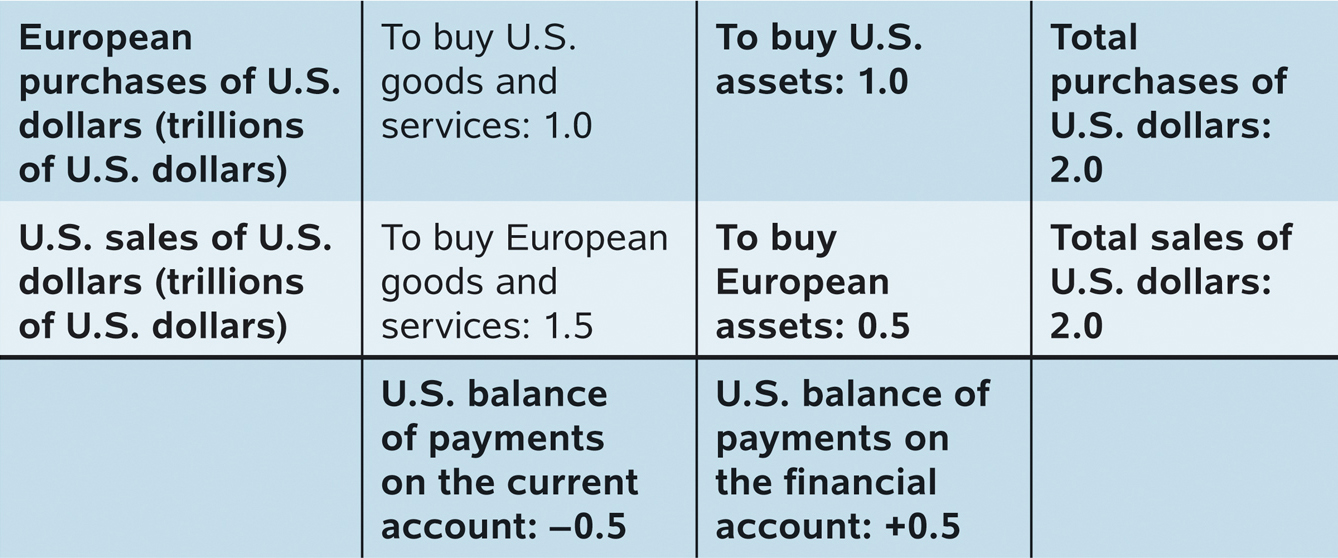
Remember that the balance of payments accounts divide international transactions into two types. Purchases and sales of goods and services are counted in the current account. (Again, we’re leaving out transfers and factor income to keep things simple.) Purchases and sales of assets are counted in the financial account. At the equilibrium exchange rate, then, we have the situation shown in Table 44-2: the sum of the balance of payments on the current account plus the balance of payments on the financial account is zero.
Now let’s briefly consider how a shift in the demand for U.S. dollars affects equilibrium in the foreign exchange market. Suppose that for some reason capital flows from Europe to the United States increase—
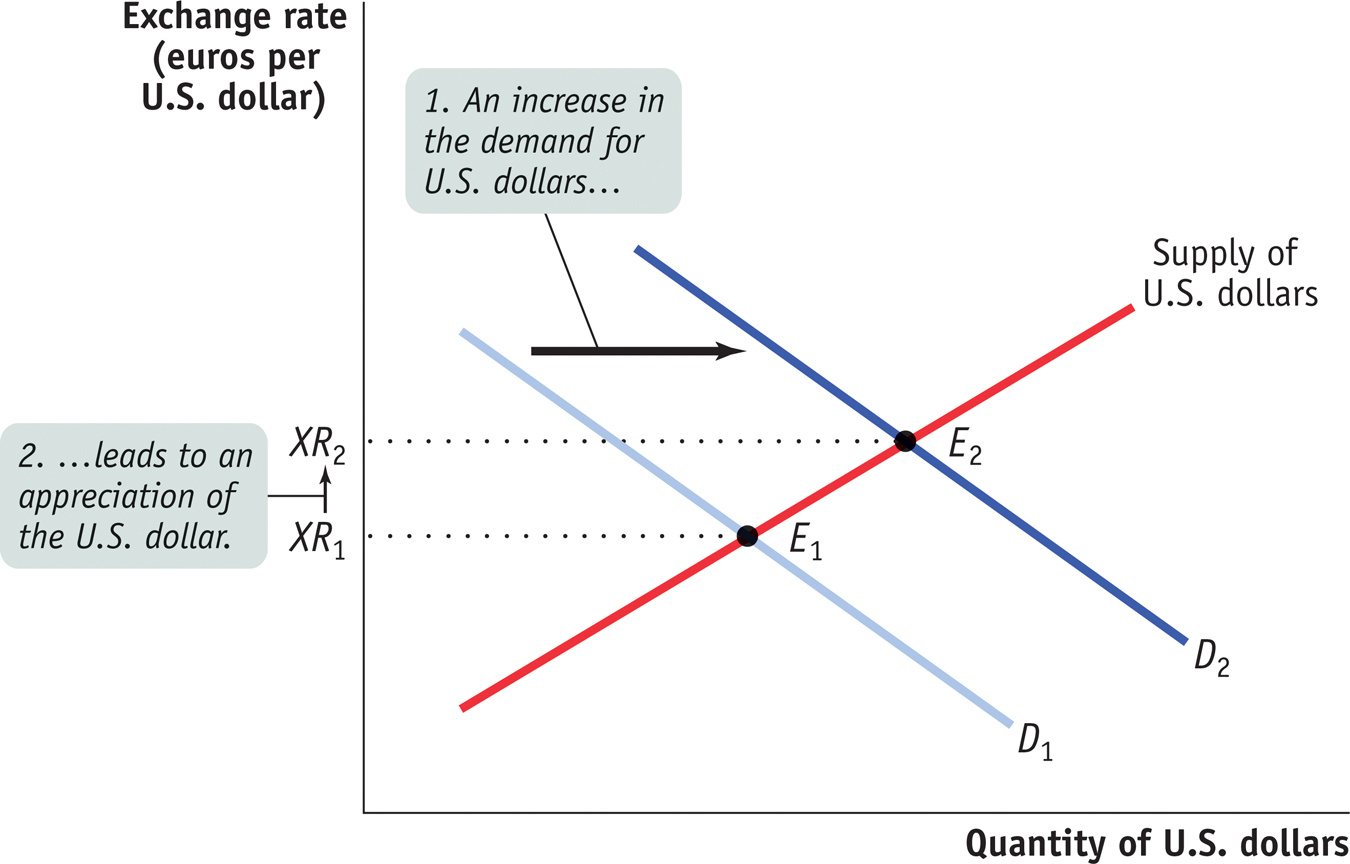
What are the consequences of this increased capital inflow for the balance of payments? The total quantity of U.S. dollars supplied to the foreign exchange market still must equal the total quantity of U.S. dollars demanded. So the increased capital inflow to the United States—
Table 44-3 shows a hypothetical example of how this might work. Europeans are buying more U.S. assets, increasing the balance of payments on the financial account from 0.5 to 1.0 trillion dollars. This is offset by a reduction in European purchases of U.S. goods and services and a rise in U.S. purchases of European goods and services, both the result of the dollar’s appreciation. So any change in the U.S. balance of payments on the financial account generates an equal and opposite reaction in the balance of payments on the current account. Movements in the exchange rate ensure that changes in the financial account and in the current account offset each other.
44-3
A Hypothetical Example of Effects of Increased Capital Inflows

Let’s briefly run this process in reverse. Suppose there is a reduction in capital flows from Europe to the United States—
Inflation and Real Exchange Rates
In 1993, one U.S. dollar exchanged, on average, for 3.1 Mexican pesos. By 2013, the peso had fallen against the dollar by more than 75%, with an average exchange rate in early 2013 of 12.1 pesos per dollar. Did Mexican products also become much cheaper relative to U.S. products over that 20-
The answer is no because Mexico had much higher inflation than the United States over that period. In fact, the relative price of U.S. and Mexican products changed little between 1993 and 2013, although the exchange rate changed a lot.
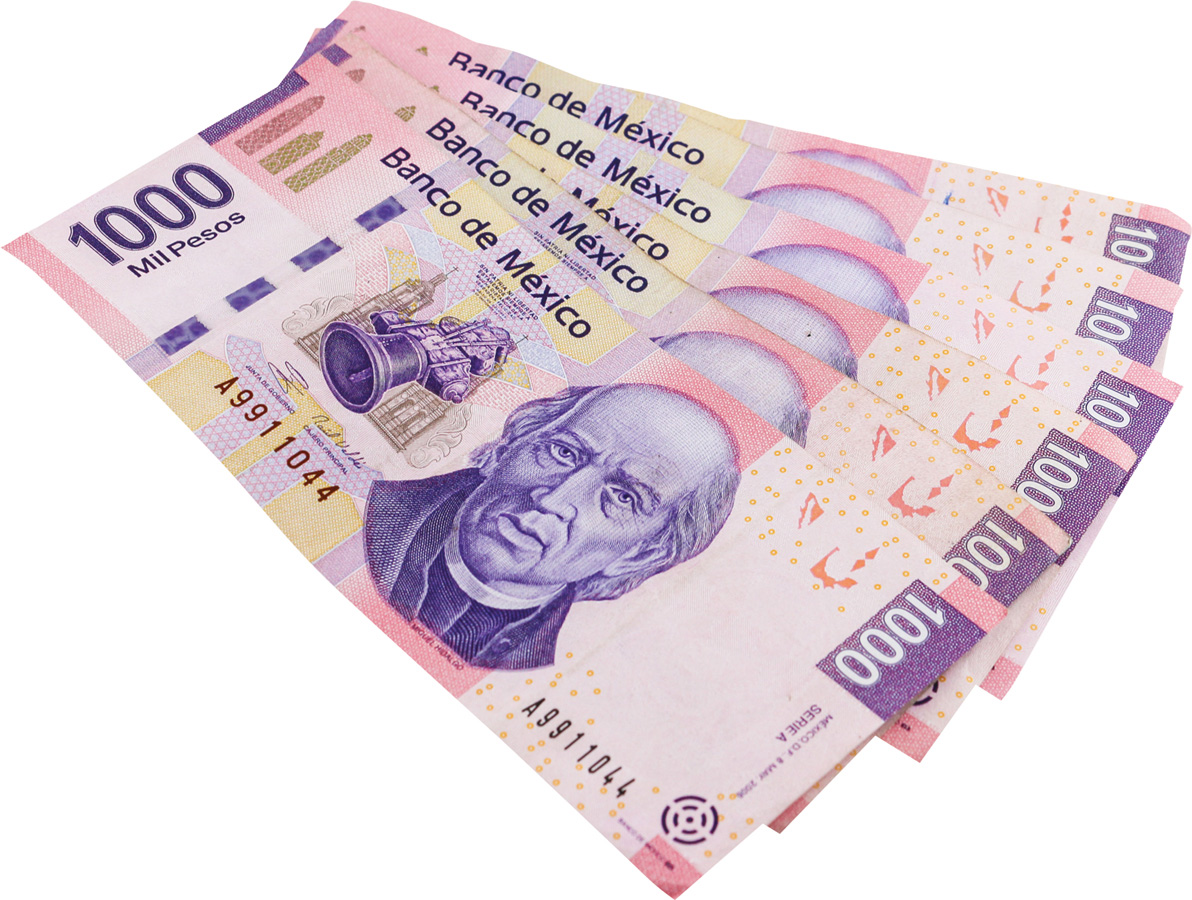
To take account of the effects of differences in inflation rates, economists calculate real exchange rates, exchange rates adjusted for international differences in aggregate price levels. Suppose that the exchange rate we are looking at is the number of Mexican pesos per U.S. dollar. Let PUS and PMex be indexes of the aggregate price levels in the in the United States and Mexico, respectively. Then the real exchange rate between the Mexican peso and the U.S. dollar is defined as:
Real exchange rates are exchange rates adjusted for international differences in aggregate price levels.

To distinguish it from the real exchange rate, the exchange rate unadjusted for aggregate price levels is sometimes called the nominal exchange rate.
To understand the significance of the difference between the real and nominal exchange rates, let’s consider the following example. Suppose that the Mexican peso depreciates against the U.S. dollar, with the exchange rate going from 10 pesos per U.S. dollar to 15 pesos per U.S. dollar, a 50% change. But suppose that at the same time the price of everything in Mexico, measured in pesos, increases by 50%, so that the Mexican price index rises from 100 to 150. We’ll assume that there is no change in U.S. prices, so that the U.S. price index remains at 100. Then the initial real exchange rate is:

After the peso depreciates and the Mexican price level increases, the real exchange rate is:

In this example, the peso has depreciated substantially in terms of the U.S. dollar, but the real exchange rate between the peso and the U.S. dollar hasn’t changed at all. And because the real peso–
To see why, consider again the example of a hotel room. Suppose that this room initially costs 1,000 pesos per night, which is $100 at an exchange rate of 10 pesos per dollar. After both Mexican prices and the number of pesos per dollar rise by 50%, the hotel room costs 1,500 pesos per night—
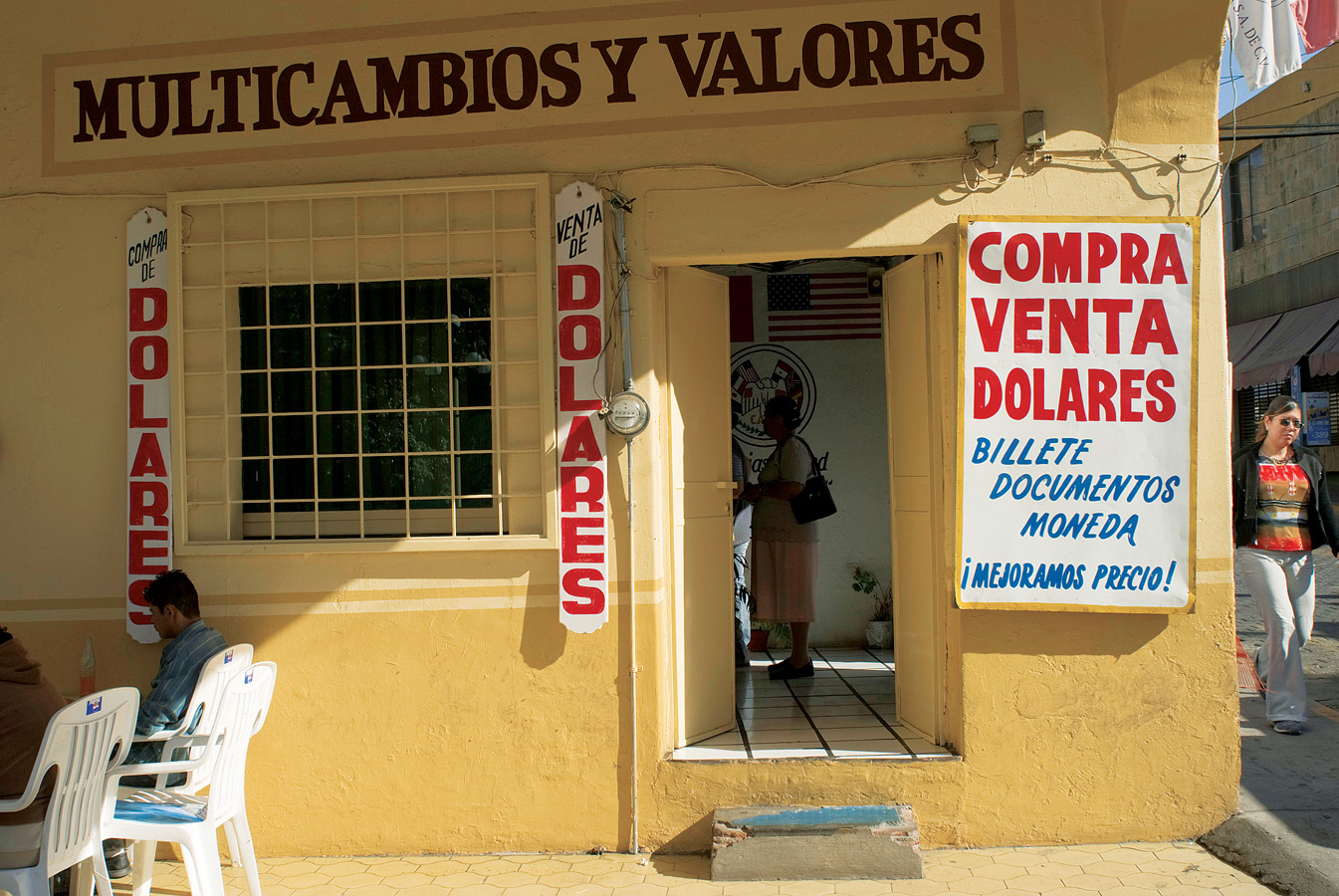
The same is true for all goods and services that enter into trade: the current account responds only to changes in the real exchange rate, not the nominal exchange rate. A country’s products become cheaper to foreigners only when that country’s currency depreciates in real terms, and those products become more expensive to foreigners only when the currency appreciates in real terms. As a consequence, economists who analyze movements in exports and imports of goods and services focus on the real exchange rate, not the nominal exchange rate.
Figure 44-3 illustrates just how important it can be to distinguish between nominal and real exchange rates. The line labeled “Nominal exchange rate” shows the number of pesos it took to buy a U.S. dollar from November 1993 to December 2011. As you can see, the peso depreciated massively over that period. But the line labeled “Real exchange rate” shows the real exchange rate: it was calculated using Equation 44-
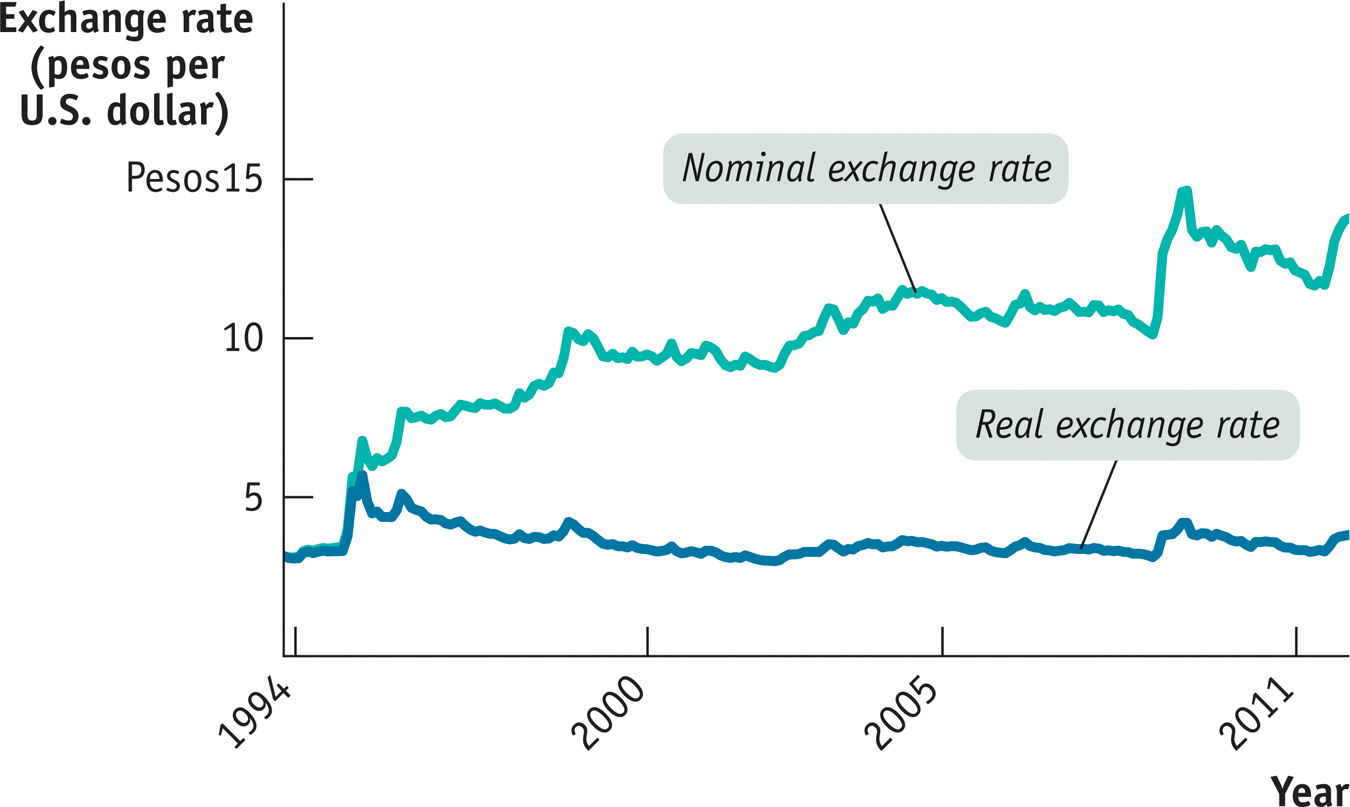
Purchasing Power Parity
The purchasing power parity between two countries’ currencies is the nominal exchange rate at which a given basket of goods and services would cost the same amount in each country.
A useful tool for analyzing exchange rates, closely connected to the concept of the real exchange rate, is known as purchasing power parity. The purchasing power parity between two countries’ currencies is the nominal exchange rate at which a given basket of goods and services would cost the same amount in each country. Suppose, for example, that a basket of goods and services that costs $100 in the United States costs 1,000 pesos in Mexico. Then the purchasing power parity is 10 pesos per U.S. dollar: at that exchange rate, 1,000 pesos = $100, so the market basket costs the same amount in both countries.
Calculations of purchasing power parities are usually made by estimating the cost of buying broad market baskets containing many goods and services—
Nominal exchange rates almost always differ from purchasing power parities. Some of these differences are systematic: in general, aggregate price levels are lower in poor countries than in rich countries because services tend to be cheaper in poor countries. But even among countries at roughly the same level of economic development, nominal exchange rates vary quite a lot from purchasing power parity.
Figure 44-4 shows the nominal exchange rate between the Canadian dollar and the U.S. dollar, measured as the number of Canadian dollars per U.S. dollar, from 1990 to 2012, together with an estimate of the purchasing power parity exchange rate between the United States and Canada over the same period. The purchasing power parity didn’t change much over the whole period because the United States and Canada had about the same rate of inflation.
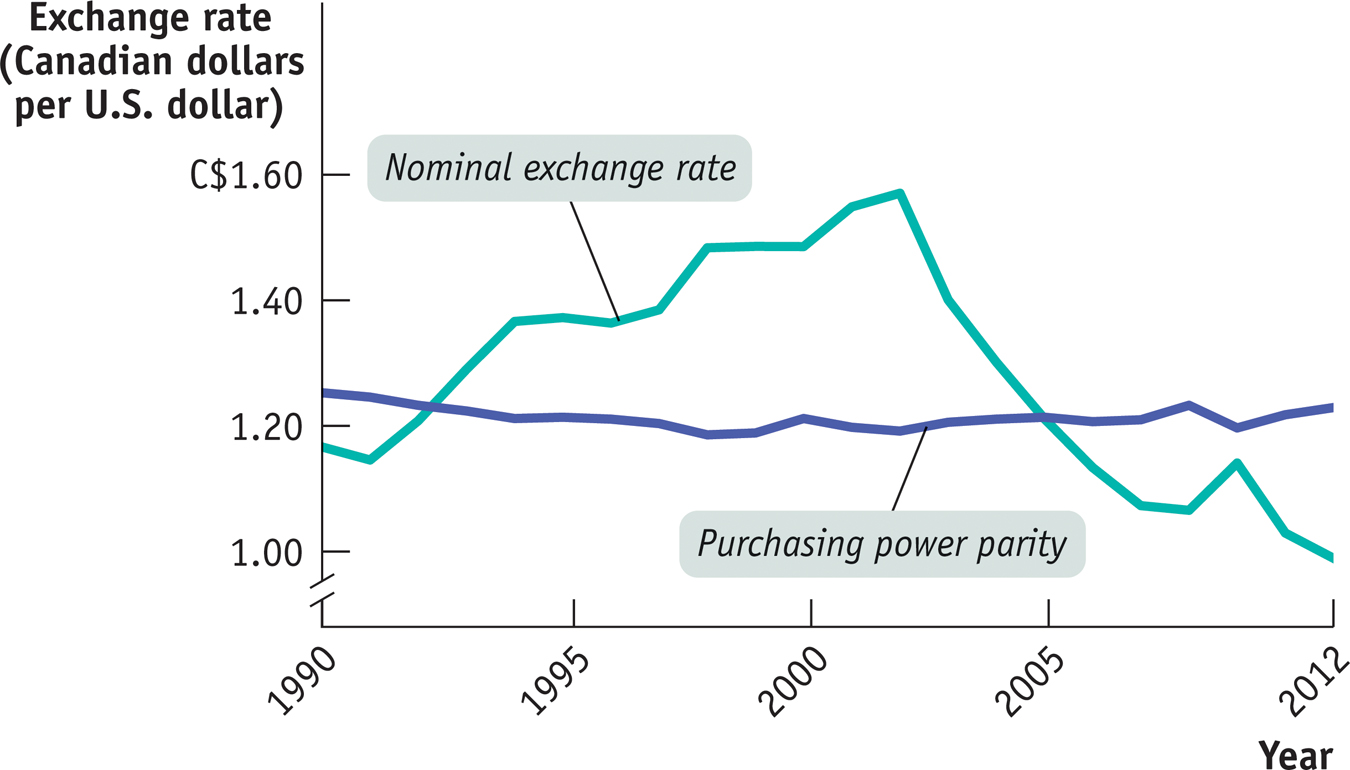
But at the beginning of the period the nominal exchange rate was below purchasing power parity, so a given market basket was more expensive in Canada than in the United States. By 2002, the nominal exchange rate was far above the purchasing power parity, so a market basket was much cheaper in Canada than in the United States.
Over the long run, however, purchasing power parities are pretty good at predicting actual changes in nominal exchange rates. In particular, nominal exchange rates between countries at similar levels of economic development tend to fluctuate around levels that lead to similar costs for a given market basket. In fact, by July 2005, the nominal exchange rate between the United States and Canada was C$1.22 per US$1—
BURGERNOMICS
For a number of years the British magazine The Economist has produced an annual comparison of the cost in different countries of one particular consumption item that is found around the world—

The magazine finds the price of a Big Mac in local currency, then computes two numbers: the price of a Big Mac in U.S. dollars using the prevailing exchange rate and the exchange rate at which the price of a Big Mac would equal the U.S. price. If purchasing power parity held for Big Macs, the dollar price of a Big Mac would be the same everywhere. If purchasing power parity is a good theory for the long run, the exchange rate at which a Big Mac’s price matches the U.S. price should offer some guidance about where the exchange rate will eventually end up.
Table 44-4 shows the Economist estimates for selected countries as of July 2013, ranked in increasing order of the dollar price of a Big Mac. The countries with the cheapest Big Macs, and therefore by this measure with the most undervalued currencies, are India and China, both developing countries.
44-4
Purchasing Power Parity and the Price of a Big Mac
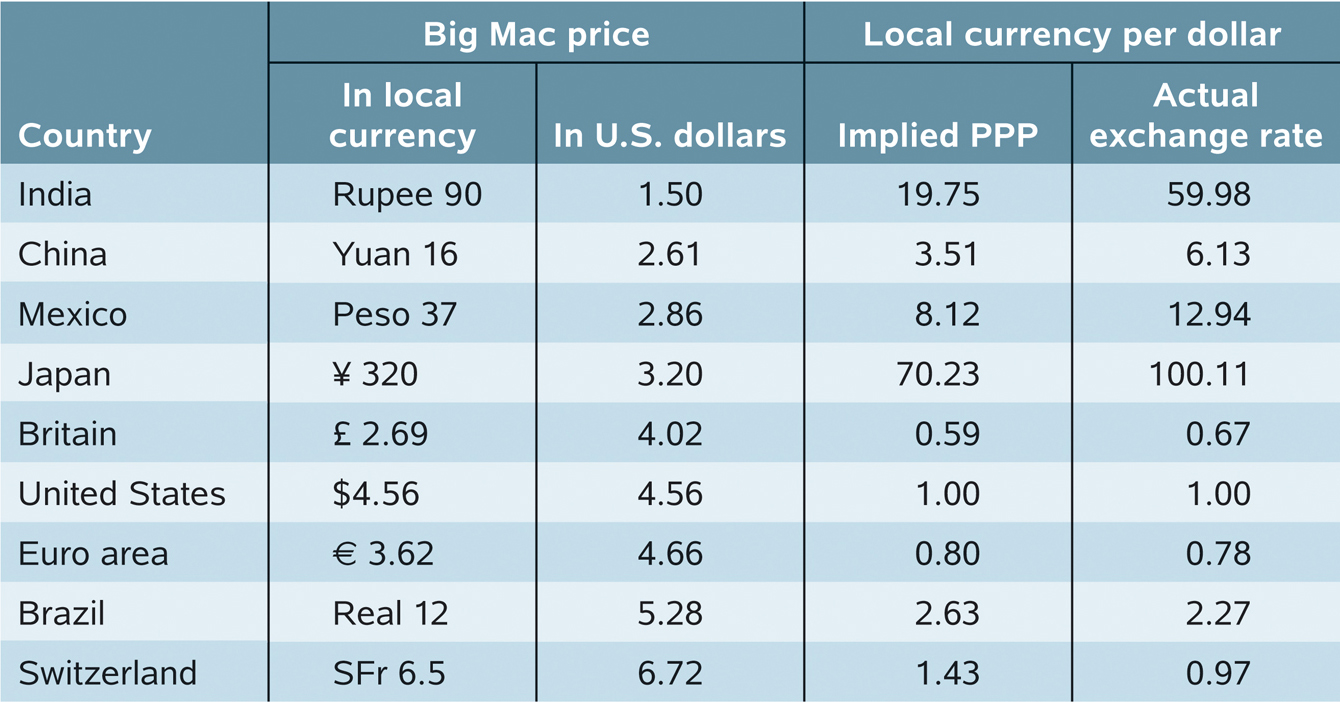
But not all developing countries have low-
44
Solutions appear at the back of the book.
Check Your Understanding
Suppose Mexico discovers huge reserves of oil and starts exporting oil to the United States. Describe how this affects the following:
-
a. the nominal peso–
U.S. dollar exchange rate The increased purchase of Mexican oil would cause U.S. individuals (and firms) to increase their demand for the peso. To purchase pesos, individuals would increase their supply of U.S. dollars to the foreign exchange market, causing a rightward shift in the supply curve of U.S. dollars. This would cause the peso price of the dollar to fall (the amount of pesos per dollar would fall). The peso would appreciate and the U.S. dollar would depreciate as a result. -
b. Mexican exports of other goods and services
With the appreciation of the peso it would take more U.S. dollars to obtain the same quantity of Mexican pesos. If we assume that the price level (measured in Mexican pesos) of other Mexican goods and services would not change, other Mexican goods and services would become more expensive to U.S. households and firms. The dollar cost of other Mexican goods and services would rise as the peso appreciated. So Mexican exports of goods and services other than oil would fall. -
c. Mexican imports of goods and services
U.S. goods and services would become cheaper in terms of pesos, so Mexican imports of goods and services would rise.
-
A basket of goods and services that costs $100 in the United States costs 800 pesos in Mexico and the current nominal exchange rate is 10 pesos per U.S. dollar. Over the next five years, the cost of that market basket rises to $120 in the United States and to 1,200 pesos in Mexico, although the nominal exchange rate remains at 10 pesos per U.S. dollar. Calculate the following:
-
a. the real exchange rate now and five years from now, if today’s price index in both countries is 100
The real exchange rate equals pesos per U.S. dollar × aggregate price level in the U.S./aggregate price level in Mexico. Today, the aggregate price level in both countries is 100. The real exchange rate today is: 10 × (100/100) = 10. The aggregate price level in five years in the U.S. will be 100 × (120/100) = 120, and in Mexico it will be 100 × (1,200/800) = 150. Thus, the real exchange rate in five years, assuming the nominal exchange rate does not change, will be 10 × (120/150) = 8. -
b. purchasing power parity today and five years from now
Today, a basket of goods and services that costs $100 costs 800 pesos, so the purchasing power parity is 8 pesos per U.S. dollar. In five years, a basket that costs $120 will cost 1,200 pesos, so the purchasing power parity will be 10 pesos per U.S. dollar.
-
Multiple-
Question
When the U.S. dollar buys more Japanese yen, the U.S. dollar has
I. become more valuable in terms of the yen
II. appreciated
III. depreciatedA. B. C. D. E. Question
The nominal exchange rate at which a given basket of goods and services would cost the same in each country describes
A. B. C. D. E. Question
What happens to the real exchange rate between the euro and the U.S. dollar (expressed as euros per dollar) if the aggregate price levels in Europe and the United States both fall? It
A. B. C. D. E. Question
Which of the following would cause the real exchange rate between pesos and U.S. dollars (in terms of pesos per dollar) to decrease?
A. B. C. D. E. Question
Which of the following will decrease the supply of U.S. dollars in the foreign exchange market?
A. B. C. D. E.
Critical-
Draw a graph of the foreign exchange market between the United States and Europe. Illustrate what would happen to the value of the U.S. dollar if there were an increase in the U.S. demand for imports from Europe.

WHICH WAY IS UP?
 You are a tourist in Mexico and need to exchange dollars for pesos. You’ve heard that the U.S. exchange rate is up, which sounds like good news. But, is it?
You are a tourist in Mexico and need to exchange dollars for pesos. You’ve heard that the U.S. exchange rate is up, which sounds like good news. But, is it?
 IT DEPENDS. TO DETERMINE IF THE DOLLAR HAS APPRECIATED OR DEPRECIATED, YOU NEED TO CHECK THE EXCHANGE RATE DATA TO FIND OUT WHICH WAY THE EXCHANGE RATE IS BEING MEASURED. Sometimes the exchange rate is measured as the price of a dollar in terms of foreign currency, sometimes it’s measured as the price of foreign currency in terms of dollars. Most countries, other than the United States, report their exchange rates in terms of the price of a dollar in their domestic currency—
IT DEPENDS. TO DETERMINE IF THE DOLLAR HAS APPRECIATED OR DEPRECIATED, YOU NEED TO CHECK THE EXCHANGE RATE DATA TO FIND OUT WHICH WAY THE EXCHANGE RATE IS BEING MEASURED. Sometimes the exchange rate is measured as the price of a dollar in terms of foreign currency, sometimes it’s measured as the price of foreign currency in terms of dollars. Most countries, other than the United States, report their exchange rates in terms of the price of a dollar in their domestic currency—
To learn more about exchange rates, see pages 464–
